Photocatalytic and Photo-Fenton-like Degradation of Cationic Dyes Using SnFe2O4/g-C3N4 Under LED Irradiation: Optimization by RSM-BBD and Artificial Neural Networks (ANNs)
Abstract
1. Introduction
2. Materials and Methods
2.1. Materials
2.2. Synthesis of g-C3N4 and SnFe2O4 Nanoparticles
2.3. Synthesis of SnFe2O4/g-C3N4 Nanocomposites
2.4. Characterisation
2.5. The Photocatalytic and Photo-Fenton-like Catalytic Activity Test
2.6. Optimization Results Using the Box–Behnken Method
2.7. Artificial Neural Network Methodology
2.8. Statistical Analysis
3. Results and Discussion
3.1. Structural Analysis
3.1.1. XRD Analysis
3.1.2. FTIR Analysis
3.2. Morphological Analysis
3.2.1. SEM/EDX Analysis Results
3.2.2. TEM Analysis Results
3.3. Photo-Fenton-like Catalytic and Photocatalytic Performance
3.3.1. The Effect of Catalyst Loading
3.3.2. Impact of the Initial Dye Concentration
3.3.3. Effect of Initial pH of the Solution
3.3.4. The Effect of H2O2 Dosage
3.4. Potential Photo-Fenton-like Mechanism
3.5. The Resistance and Recycling Capacity of the Catalyst
3.6. Experimental Optimization via the Response Surface Methodology (RSM)
3.6.1. Statistical Model Analysis
3.6.2. Response Surface and Contour Diagrams
3.6.3. Optimal Conditions for the Photo-Fenton-like Process
3.7. ANN Architecture Optimization
3.8. Global Sensitivity Analysis
3.9. Comparison of RSM and ANN
4. Conclusions
Supplementary Materials
Author Contributions
Funding
Data Availability Statement
Conflicts of Interest
References
- Bouwer, H. Integrated water management for the 21st century: Problems and solutions. J. Irrig. Drain. Eng. 2002, 128, 193–202. [Google Scholar]
- Dogan, M.; Alkan, M. Adsorption kinetics of methyl violet onto perlite. Chemosphere 2003, 50, 517–528. [Google Scholar]
- Jamil, T. Role of advance oxidation processes (AOPs) in textile wastewater treatment: A critical review. Desalination Water Treat. 2024, 318, 100387. [Google Scholar]
- Gogate, P.R.; Pandit, A.B. A review of imperative technologies for wastewater treatment I: Oxidation technologies at ambient conditions. Adv. Environ. Res. 2004, 8, 501–551. [Google Scholar]
- Kong, H.J.; Won, D.H.; Kim, J.; Woo, S.I. Sulfur-Doped gC3N4/BiVO4 Composite Photocatalyst for Water Oxidation under Visible Light. Chem. Mater. 2016, 28, 1318–1324. [Google Scholar] [CrossRef]
- Kocijan, M.; Podlogar, M. Perspective Chapter: Modification Engineering of Titanium Dioxide-Based Nanostructured Photocatalysts for Efficient Removal of Pollutants from Water. In Titanium Dioxide—Uses, Applications, and Advances; IntechOpen: London, UK, 2024. [Google Scholar]
- Gul, S.; Yousuf, M.A.; Anwar, A.; Warsi, M.F.; Agboola, P.O.; Shakir, I.; Shahid, M. Alsubstituted zinc spinel ferrite nanoparticles: Preparation and evaluation of structural, electrical, magnetic and photocatalytic properties. Ceram. Int. 2020, 46, 14195–14205. [Google Scholar]
- Hoffmann, M.R.; Martin, S.T.; Choi, W.; Bahnemann, D.W. Environmental Applications of Semiconductor Photocatalysis. Chem. Rev. 1995, 95, 69–96. [Google Scholar] [CrossRef]
- Chakraborty, T.; Sharma, S.; Debnath, T.; Mahapatra, A.S.; Selvam, A.; Chakrabarti, S.; Sutradhar, S. Fabrication of heterostructure composites of Ni-Zn-Cu-ferrite-C3N4-poly(vinylidene fluoride) films for the enhancement of electromagnetic interference shielding effectiveness. Chem. Eng. J. 2021, 420, 127683. [Google Scholar]
- Niu, P.; Zhang, L.; Liu, G.; Cheng, H.M. Graphene-Like Carbon Nitride Nanosheets for Improved Photocatalytic Activities. Adv. Funct. Mater. 2012, 22, 4763–4770. [Google Scholar] [CrossRef]
- Iftikhar, S.; Warsi, M.F.; Haider, S.; Musaddiq, S.; Shakir, I.; Shahid, M. The impact of carbon nanotubes on the optical, electrical, and magnetic parameters of Ni2+ and Co2+ based spinel ferrites. Ceram. Int. 2019, 45, 21150–21161. [Google Scholar]
- Li, Y.; Chen, D.; Fan, S.; Yang, T. Enhanced visible light assisted Fenton-like degradation of dye via metal-doped zinc ferrite nanosphere prepared from metalrich industrial wastewater. J. Taiwan Inst. Chem. Eng. 2019, 96, 185–192. [Google Scholar] [CrossRef]
- Sun, X.; Huang, L.; Wang, G.; Feng, H.; Zhou, S.; Zhao, R.; Wang, D.; Li, Z. Efficient degradation of tetracycline under the conditions of high-salt and coexisting substances by magnetic CuFe2O4/g-C3N4 photo-Fenton process. Chemosphere 2022, 308, 136204. [Google Scholar] [CrossRef] [PubMed]
- Liu, Y.; Song, Y.; You, Y.; Fu, X.; Wen, J.; Zheng, X. NiFe2O4/g-C3N4 heterojunction composite with enhanced visible-light photocatalytic activity. J. Saudi Chem. Soc. 2018, 22, 439–448. [Google Scholar] [CrossRef]
- Sun, H.; Zhou, T.; Kang, J.; Zhao, Y.; Zhang, Y.; Wang, T.; Yin, X. High-efficient degradation of oxytetracycline by visible photo-Fenton process using MnFe2O4/g-C3N4: Performance and mechanisms. Sep. Purif. Technol. 2022, 299, 121771. [Google Scholar] [CrossRef]
- Yao, Y.; Wu, G.; Lu, F.; Wang, S.; Hu, Y.; Huang, W.; Wei, F. Enhanced photo-Fenton-like process over Z-scheme CoFe2O4/g-C3N4 Heterostructures under natural indoor light. Environ. Sci. Pollut. Res. 2016, 23, 21833–21845. [Google Scholar] [CrossRef] [PubMed]
- Yao, Y.; Cai, Y.; Lu, F.; Qin, J.; Wei, F.; Xu, C. Magnetic ZnFe2O4−C3N4 hybrid for photocatalytic degradation of aqueous organic pollutants by visible light. Ind. Eng. Chem. Res. 2014, 53, 17294–17302. [Google Scholar] [CrossRef]
- Lu, A.H.; Salabas, E.L.; Schüth, F. Magnetic nanoparticles: Synthesis, protection, functionalization, and application. Angew. Chem. Int. Ed. 2007, 46, 1222–1244. [Google Scholar] [CrossRef]
- Baladi, E.; Davar, F.; Hojjati-Najafabadi, A. Synthesis and characterization of g–C3N4–CoFe2O4–ZnO magnetic nanocomposites for enhancing photocatalytic activity with visible light for degradation of penicillin G antibiotic. Environ. Res. 2022, 215 Pt 2, 114270. [Google Scholar] [CrossRef]
- Huang, S.; Xu, Y.; Xie, M.; Xu, H.; He, M.; Xia, J.; Li, H. Synthesis of magnetic CoFe2O4/g-C3N4 composite and its enhancement of photocatalytic ability under visible-light. Colloids Surf. A 2015, 478, 71–80. [Google Scholar] [CrossRef]
- Sun, J.; Lin, X.; Xie, J.; Zhang, Y.; Wang, Q.; Ying, Z. Facile synthesis of novel ternary g-C3N4/ferrite/biochar hybrid photocatalyst for efficient degradation of methylene blue under visible-light irradiation. Colloids Surf. A Physicochem. Eng. Asp. 2020, 606, 125556. [Google Scholar] [CrossRef]
- Khan, M.A.M.; Khan, W.; Ahamed, M.; Ahmed, J.; Al-Gawati, M.A.; Alhazaa, A.N. Silver-decorated cobalt ferrite nanoparticles anchored onto the graphene sheets as electrode materials for electrochemical and photocatalytic applications. ACS Omega 2020, 5, 31076–31084. [Google Scholar]
- Vignesh, K.; Suganthi, A.; Min, B.K.; Kang, M. Photocatalytic activity of magnetically recoverable MnFe2O4/g-C3N4/TiO2 nanocomposite under simulated solar light irradiation. J. Mol. Catal. A Chem. 2014, 395, 373–383. [Google Scholar]
- Chen, L.; Ma, W.; Dai, J.; Zhao, J.; Li, C.; Yan, Y. Facile synthesis of highly efficient graphitic-C3N4/ZnFe2O4 heterostructures enhanced visible-light photocatalysis for spiramycin degradation. J. Photochem. Photobiol. A 2016, 328, 24–32. [Google Scholar]
- Palanivel, B.; Hu, C.; Shkir, M.; AlFaify, S.; Ibrahim, F.A.; Hamdy, M.S.; Mani, A. Hétérojonction NiFe2O4 couplée au g-C3N4 dopé au fluor: Consommation de H2O2 pour la production de radicaux hydroxyles en vue de la dégradation du paracétamol. Commun. Sci. Colloïdes Interfaces 2021, 42, 100410. [Google Scholar] [CrossRef]
- Yao, Y.; Lu, F.; Zhu, Y.; Wei, F.; Liu, X.; Lian, C.; Wang, S. Magnetic core–shell CuFe2O4@C3N4 hybrids for visible light photocatalysis of Orange II. J. Hazard. Mater. 2015, 297, 224–233. [Google Scholar] [CrossRef] [PubMed]
- Rai, P.; Gautam, R.K.; Banerjee, S.; Rawat, V.; Chattopadhyaya, M.C. Synthesis and characterization of a novel SnFe2O4@activated carbon magnetic nanocomposite and its effectiveness in the removal of crystal violet from aqueous solution. J. Environ. Chem. Eng. 2015, 3, 2281–2291. [Google Scholar]
- Jia, Y.; Rhee, S.J.; Liu, C. Recyclability of g-C3N4/SnFe2O4 for CTC degradation, (B) magnetic hysteresis loops, (C) effects of series of scavengers on the degradation efficiency of CTC, (D) schematic of the photocatalytic degradation of CTC on g-C3N4/SnFe2O4. Mater. Lett. 2017, 188, 338–342. [Google Scholar]
- Lee, K.T.; Lu, S.Y. A cost-effective, stable, magnetically recyclable photocatalyst of ultra-high organic pollutant degradation efficiency: SnFe2O4 nanocrystals from a carrier solvent. J. Mater. Chem. A 2015, 3, 12259–12267. [Google Scholar]
- Jia, Y.; Kim, D.H.; Lee, B.W.; Rhee, S.J.; Kang, S.; Lee, T.; Liu, C. One-pot solvothermal synthesis of magnetic SnFe2O4 nanoparticles and their performance in the photocatalytic degradation of chlortetracycline with visible light radiation. RSC Adv. 2016, 6, 76542–76550. [Google Scholar]
- Arslan-Alaton, I.; Tureli, G.; Olmez-Hanci, T. Traitement des eaux usées de production de colorants azoïques par des procédés d’oxydation avancée de type Photo-Fenton: Optimisation par méthodologie de surface de réponse. J. Photochem. Photobiol. A Chem. 2009, 202, 142–153. [Google Scholar]
- Salari, M.; Nikoo, M.R.; Al-Mamoun, A.; Rakhshandehroo, G.R.; Mooselu, M.G. Optimisation du processus de type Fenton, homogène à pH neutre pour la dégradation de la ciprofloxacine: Comparaison de RSM-CCD et ANN-GA. J. Environ. Gérer. 2022, 317, 115469. [Google Scholar]
- Khiar, H.; Janani, F.Z.; Sadiq, M.; Qourzal, S.; Puga, A.; Barka, N. Hétérojonction Ag3PO4: Nn décorée MoO3 pour des performances photocatalytiques élevées et une stabilité améliorée. Bull. Rech. Mat. 2025, 184, 113253. [Google Scholar]
- Alahiane, S.; Qourzal, S.; El Ouardi, M.; Abaamrane, A.; Assabbane, A. Facteurs influençant la dégradation photocatalytique du jaune réactif 145 par les fibres non tissées revêtues de TiO2. Am. J. Anal. Chem. 2014, 5, 46558. [Google Scholar]
- Speck, F.; Raja, S.; Ramesh, V.; Thivaharan, V. Modeling and Optimization of Homogeneous Photo-Fenton Degradation of Rhodamine B by Response Surface Methodology and Artificial Neural Network. Int. J. Environ. Res. 2016, 10, 543–554. [Google Scholar]
- Berkani, M.; Kadmi, Y.; Bouchareb, M.K.; Bouhelassa, M.; Bouzaza, A. Combination of a Box-Behnken design technique with response surface methodology for optimization of the photocatalytic mineralization of C.I. Basic Red 46 dye from aqueous solution. Arab J. Chem. 2020, 13, 8338–8346. [Google Scholar]
- El-Habacha, M.; Lagdali, S.; Dabagh, A.; Mahmoudy, G.; Assouani, A.; Benjelloun, M.; Miyah, Y.; Iaich, S.; Chiban, M.; Zerbet, M. High efficiency of sodium hydroxide-treated phengite clay for adsorption of Congo red dye: Optimization, cost estimation, and mechanism study. Environ. Res. 2024, 259, 119542. [Google Scholar]
- Ray, S.; Haque, M.; Ahmed, T.; Nahin, T.T. Comparison of artificial neural network (ANN) and response surface methodology (RSM) in predicting the compressive and splitting tensile strength of concrete prepared with glass waste and tin (Sn) can fiber. J. King Saud Univ. Eng. Sci. 2023, 35, 185–199. [Google Scholar]
- de Luna, M.D.G.; Sablas, M.M.; Hung, C.-M.; Chen, C.-W.; Garcia-Segura, S.; Dong, C.-D. Modeling and optimization of imidacloprid degradation by catalytic percarbonate oxidation using artificial neural network and Box-Behnken experimental design. Chemosphere 2020, 251, 126254. [Google Scholar]
- Boukarma, L.; Aboussabek, A.; El Aroussi, F.; Zerbet, M.; Sinan, F.; Chiban, M. Insight into mechanism, Box-Behnken design, and artificial neural network of cationic dye biosorption by marine macroalgae Fucus spiralis. Algal Res. 2023, 76, 103324. [Google Scholar]
- Lee, J.H.; Kim, H.J. Application of response surface methodology to optimize the photocatalytic degradation of dyes using composite photocatalysts. Chem. Eng. J. 2020, 385, 123317. [Google Scholar]
- Jia, Y.; Rhee, S.J.; Liu, C. Synthèse d’un composite g-C3N4/SnFe2O4 magnétique récupérable avec des propriétés photocatalytiques améliorées en lumière visible. Mater. Lett. 2017, 188, 338–342. [Google Scholar] [CrossRef]
- Jo, W.-K.; Moru, S.; Tonda, S. Photocatalyseurs hybrides SnFe2O4/g-C3N4 magnétiquement réactifs avec des performances remarquables induites par la lumière visible pour la dégradation de substances dangereuses et la production durable d’hydrogène. Appl. Surf. Sci. 2020, 506, 144939. [Google Scholar] [CrossRef]
- Jo, W.-K.; Moru, S.; Tonda, S. Magnetically responsive SnFe2O4/g-C3N4 hybrid photocatalysts with remarkable visible-light-induced performance for degradation of environmentally hazardous substances and sustainable hydrogen production. Appl. Surf. Sci. 2020, 506, 144939. [Google Scholar] [CrossRef]
- Han, H.; Luo, Y.; Jia, Y.; Hasan, N.; Liu, C. A review on SnFe2O4 and their composites: Synthesis, properties, and emerging applications. Prog. Nat. Sci. Mater. Int. 2022, 32, 517–527. [Google Scholar] [CrossRef]
- Jiang, H.; Chen, H.; Fu, Y.; Guo, C. SnFe2O4 mediated near-infrared-driven photocatalysis, photothermal sterilization and piezocatalysis. Appl. Surf. Sci. 2023, 611, 155555. [Google Scholar] [CrossRef]
- Soufi, A.; Khnifira, M.; Hajjaoui, H.; Bessbousse, H.; Barka, N. Effect of MgFe2O4 catalyst preparation method on its surface characteristics and Fenton-like oxidation of tartrazine: Statistical comparison and DFT-assisted prediction of mechanism. Mater. Today Commun. 2023, 35, 105737. [Google Scholar] [CrossRef]
- Jia, Y.; Ma, H.; Zhang, W.; Zhu, G.; Yang, W.; Son, N.; Kang, M.; Liu, C. Z-scheme SnFe2O4-graphitic carbon nitride: Reusable, magnetic catalysts for enhanced photocatalytic CO2 reduction. Chem. Eng. J. 2020, 383, 123172. [Google Scholar] [CrossRef]
- Zhao, M.; Wang, X. Role of dye adsorption in enhancing photocatalytic performance: A review. Appl. Catal. B Environ. 2021, 284, 119760. [Google Scholar]
- Palanivel, B.; Perumal, S.M.; Maiyalagan, T.; Jayarman, V.; Ayyappan, C.; Alagiri, M. Rational design of ZnFe2O4/g-C3N4 nanocomposite for enhanced photo-Fenton reaction and supercapacitor performance. Appl. Surf. Sci. 2019, 498, 143807. [Google Scholar] [CrossRef]
- Nguyen, L.T.; Duong, A.T.; Bui, N.D.; Ngo, V.T.; Nguyen, H.Q.; Nguyen, H.T.; Tran, G.T.; Tran, T.V. Synthèse de photocatalyseurs magnétiques à hétérojonction NiFe2O4/g-C3N4 pour améliorer les performances de dégradation des colorants sous irradiation à la lumière visible. Soc. R. Chim. 2024, 7, 536–548. [Google Scholar]
- Ismael, M. Photo-Fenton reaction enhanced visible-light activity of p-CuFe2O4/n-g-C3N4 heterojunction composites synthesized by a simple ultrasonic-assisted route for organic pollutants degradation. Mater. Res. Bull. 2022, 151, 111803. [Google Scholar]
- Ji, H.; Jing, X.; Xu, Y.; Yan, J.; Li, H.; Li, Y.; Huang, L.; Zhang, Q.; Xu, H.; Li, H. Magnetic g-C3N4/NiFe2O4 hybrids with enhanced photocatalytic activity. RSC Adv. 2015, 5, 57960–57967. [Google Scholar] [CrossRef]
- O’Dowd, K.; Pillai, S.C. Photo-Fenton disinfection at near neutral pH: Process, parameter optimization and recent advances. J. Environ. Chem. Eng. 2020, 8, 104063. [Google Scholar]
- Zhang, J.; Lin, Y.; Liu, L. Electron transfer in heterojunction catalysts. Phys. Chem. Chem. Phys. 2023, 25, 7106–7119. [Google Scholar] [CrossRef]
- Li, N.; Zhang, J.; Tian, Y.; Zhao, J.; Zhang, J.; Zuo, W. Precisely controlled fabrication of magnetic 3D γ-Fe2O3@ZnO core-shell photocatalyst with enhanced activity: Ciprofloxacin degradation and mechanism insight. Chem. Eng. 2017, 308, 377–385. [Google Scholar]
- Xu, F.; He, Y.; Zhang, J.; Liang, G.; Liu, C.; Yu, J. Prolonging charge carrier lifetime via intraband defect levels in S-scheme heterojunctions for artificial photosynthesis. Angew. Chem. Int. Ed. 2025, 64, e202414672. [Google Scholar] [CrossRef]
- Hosseini, O.; Zare-Shahabadi, V.; Ghaedi, M.; Ahmadi Azqhandi, M.H. Experimental design, RSM and ANN modeling of tetracycline photocatalytic degradation using LDH@CN. J. Environ. Chem. Eng. 2022, 10, 108345. [Google Scholar]
- Mourabet, M.; El Rhilassi, A.; El Boujaady, H.; Bennani-Ziatni, M.; Taitai, A. Use of response surface methodology for optimization of fluoride adsorption in an aqueous solution by Brushite Arab. J. Chem. 2017, 10, S3292–S3302. [Google Scholar]
- Soufi, A.; Hajjaoui, H.; Elmoubarki, R.; Abdennouri, M.; Qourzal, S.; Barka, N. Heterogeneous Fenton-like degradation of tartrazine using CuFe2O4 nanoparticles synthesized by sol-gel combustion. Appl. Surf. Sci. Adv. 2022, 9, 100251. [Google Scholar] [CrossRef]
- Tolba, A.; Alalm, M.G.; Elsamadony, M.; Mostafa, A.; Afify, H.; Dionysiou, D.D. Modélisation et optimisation de processus hétérogènes de type Fenton et photo-Fenton utilisant des nanotubes de carbone Fe3O4-MWCNT réutilisables. Sécurité Procédés Prot. L’environnement 2019, 128, 273–283. [Google Scholar]
- Mugendiran, V.; Gnanavelbabu, A.; Ramadoss, R. Parameter optimization for surface roughness and wall thickness on AA5052 Aluminium alloy by incremental forming using response surface methodology. Proc. Eng. 2014, 97, 1991–2000. [Google Scholar] [CrossRef]
- Khasraghi, A.; Zare, K.; Mehrizad, A.; Modirshahla, N.; Behnajady, M.A. Zeolite 4A supported CdS/g-C3N4 type-II heterojunction: A novel visible-light-active ternary nanocomposite for potential photocatalytic degradation of cefoperazone. J. Mol. Liq. 2021, 342, 117479. [Google Scholar]
- Boucherit, N.; Hanini, S.; Ibrir, A.; Laidi, M.; Roubehie-Fissaa, M. Removal of Chlortetracycline Chlorhydrate by Photo-Fenton Process. Kem. Ind. 2023, 72, 627–637. [Google Scholar] [CrossRef]
- Kassahun, S.K.; Kiflie, Z.; Kim, H.; Baye, A.F. Process optimization and kinetics analysis for photocatalytic degradation of emerging contaminant using N-doped TiO2-SiO2 nanoparticle: Artificial Neural Network and Surface Response Methodology approach. Environ. Technol. Innov. 2021, 23, 101761. [Google Scholar] [CrossRef]

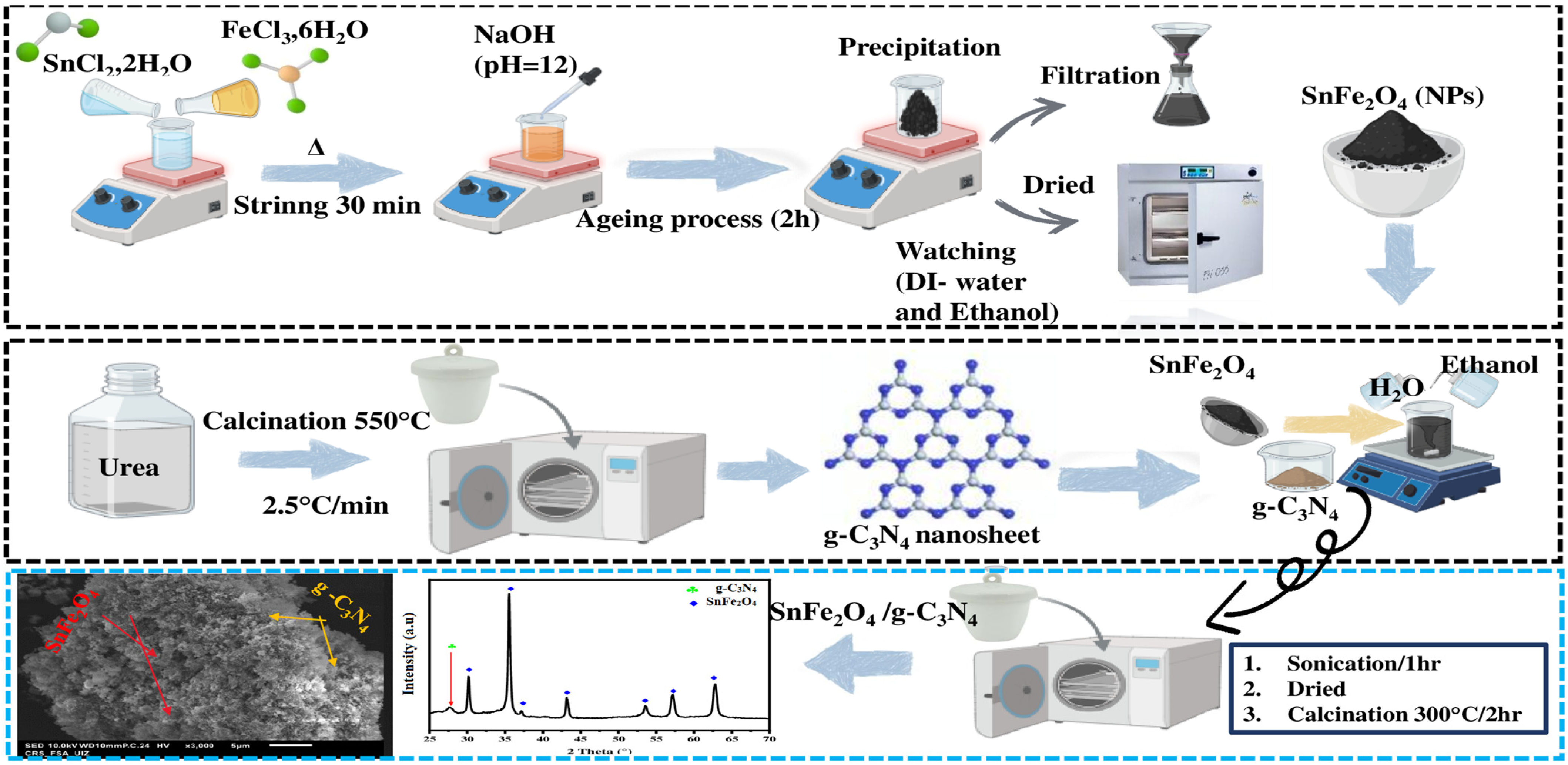
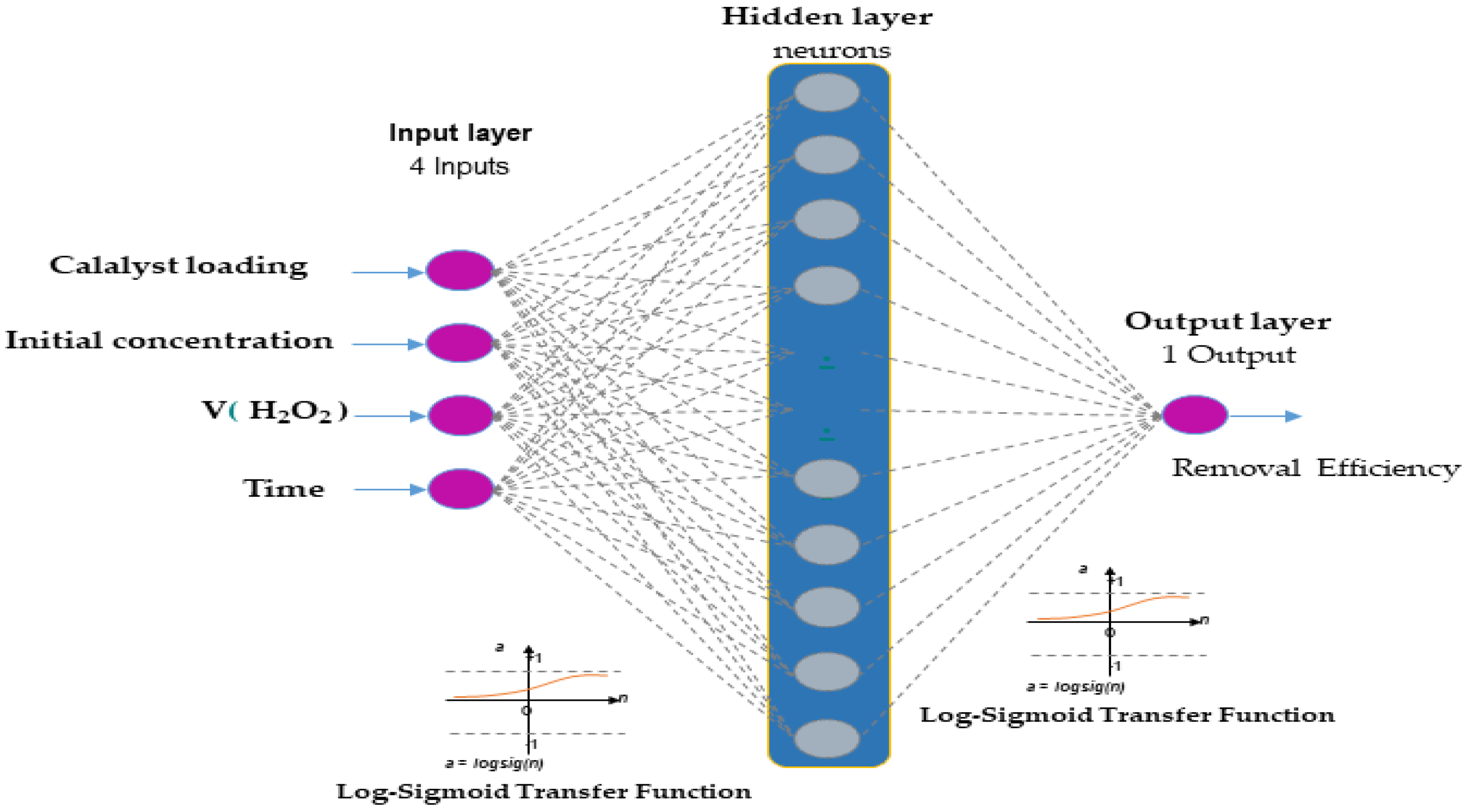
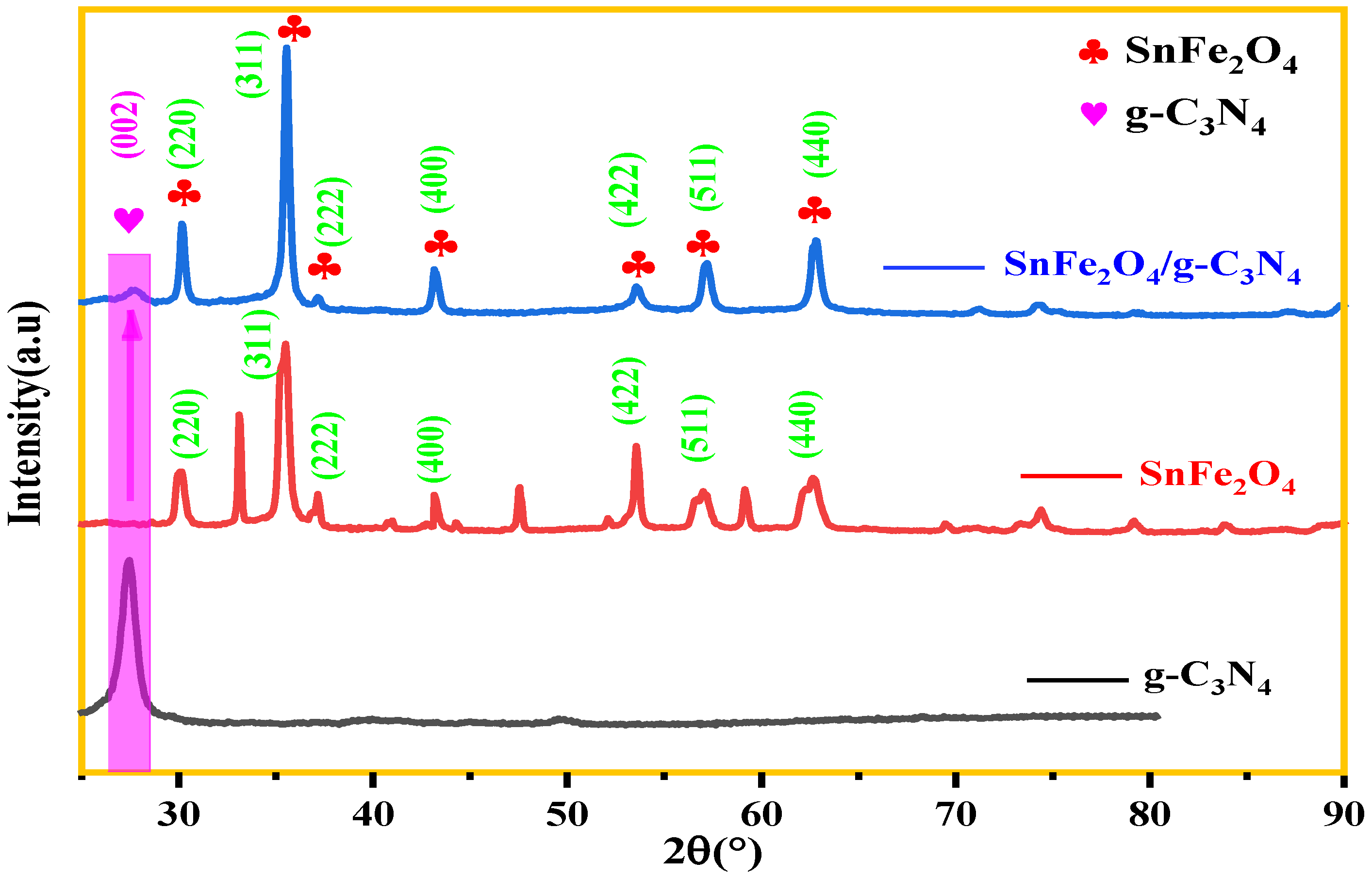
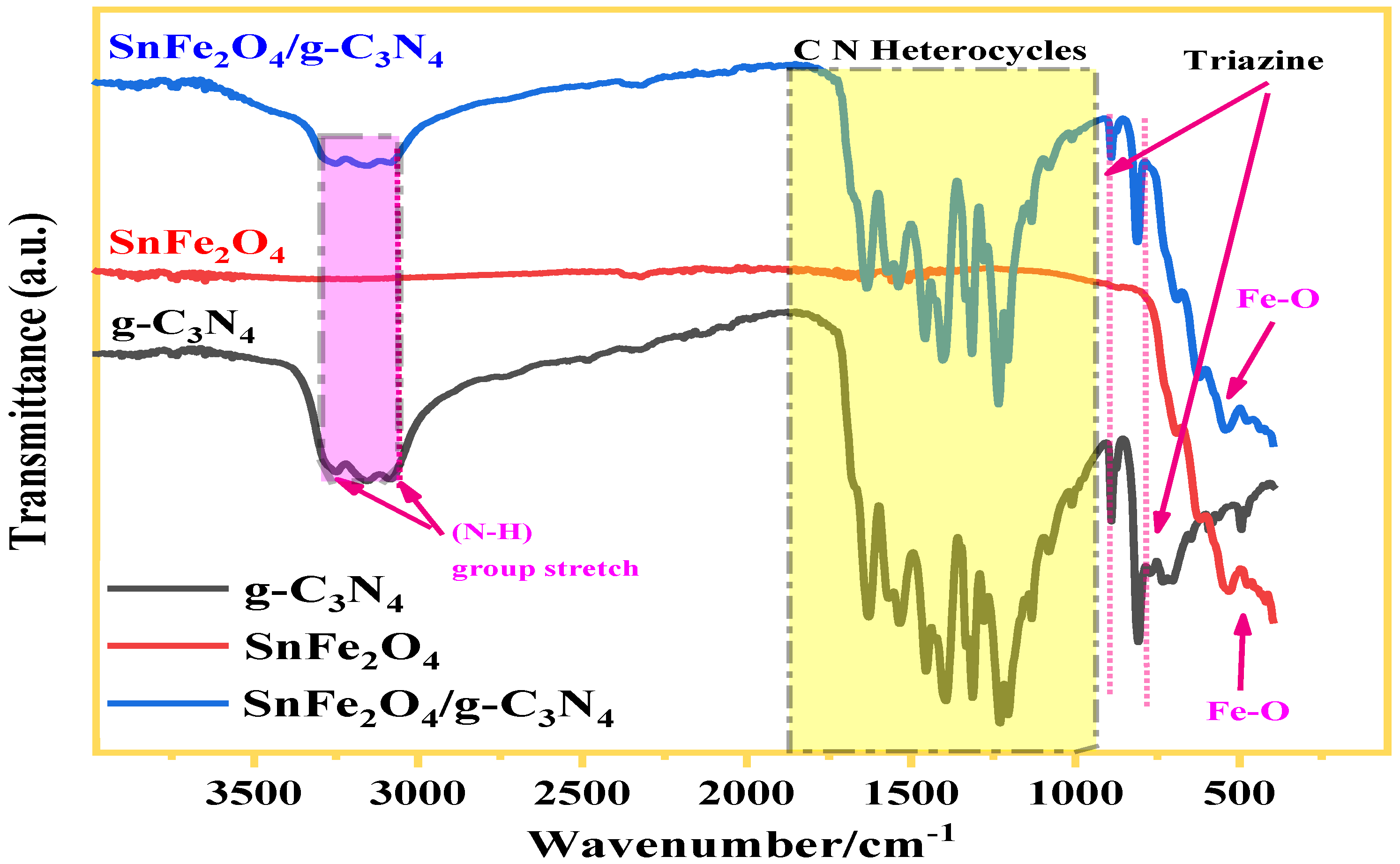
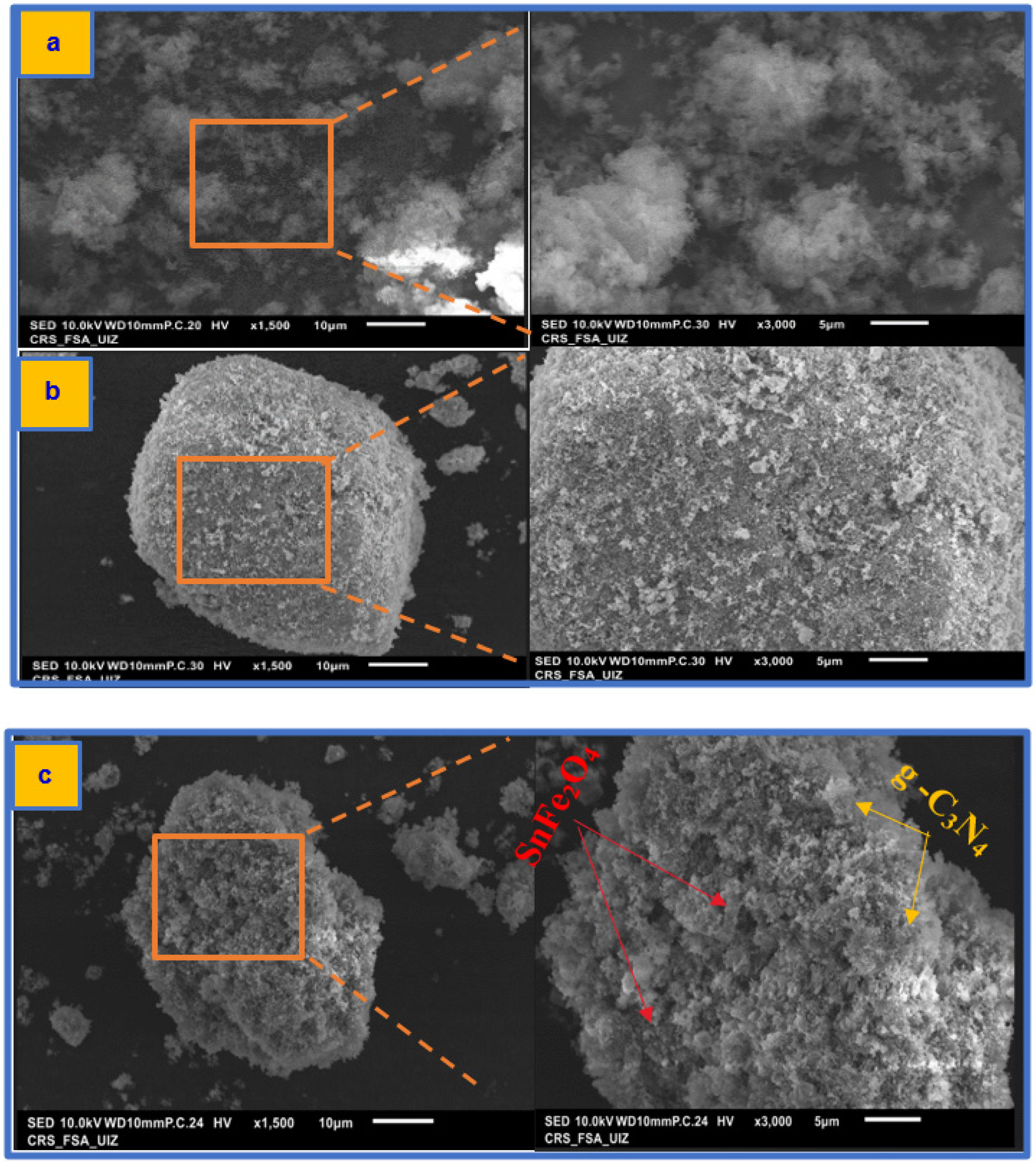
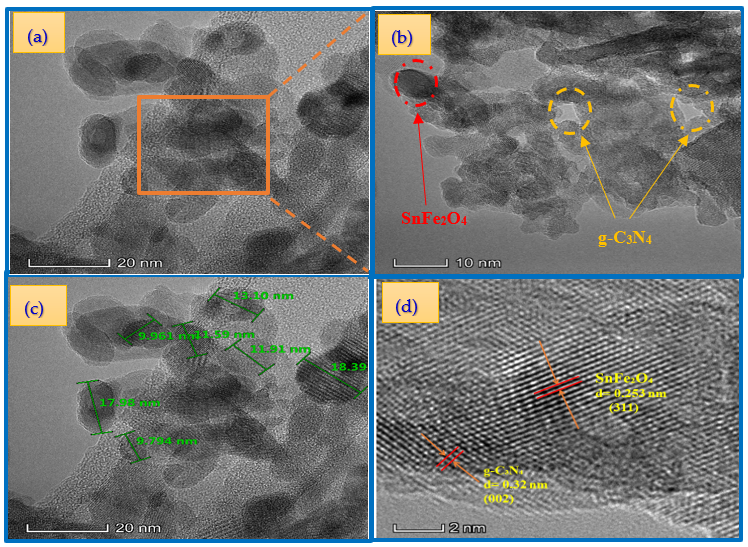
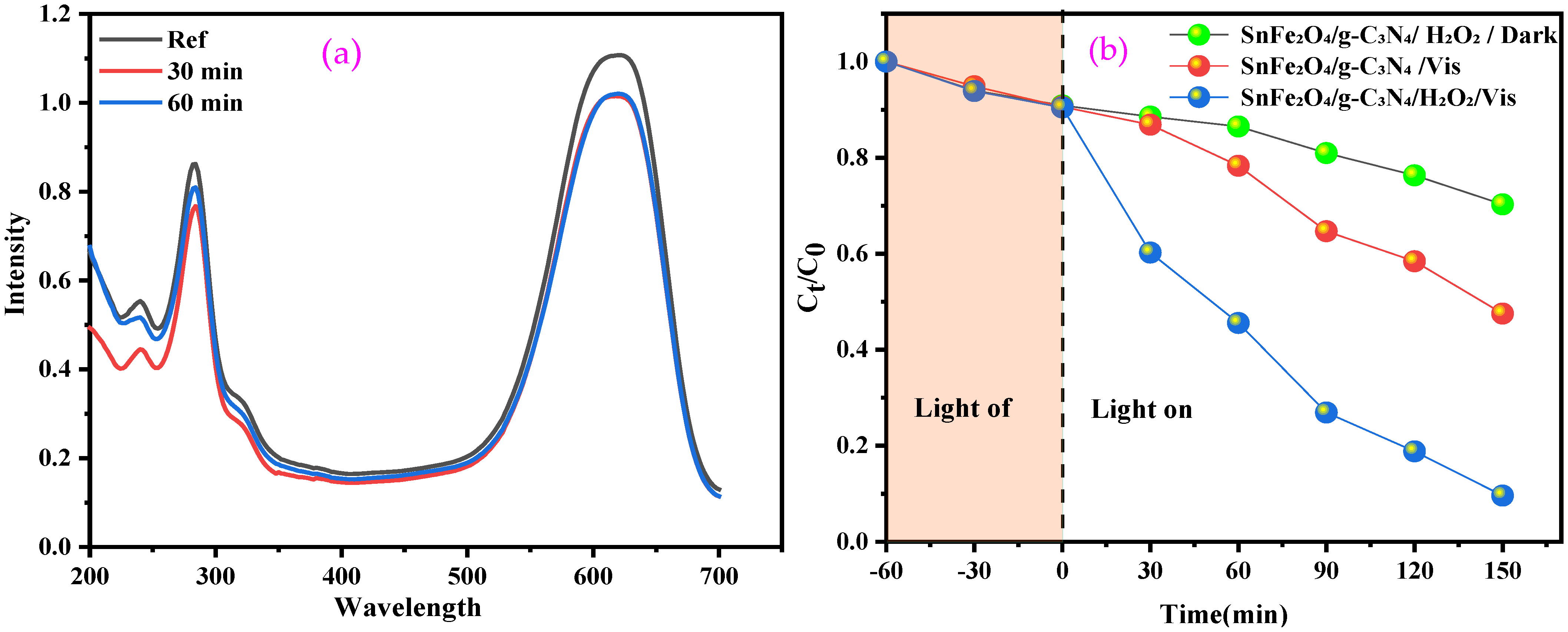
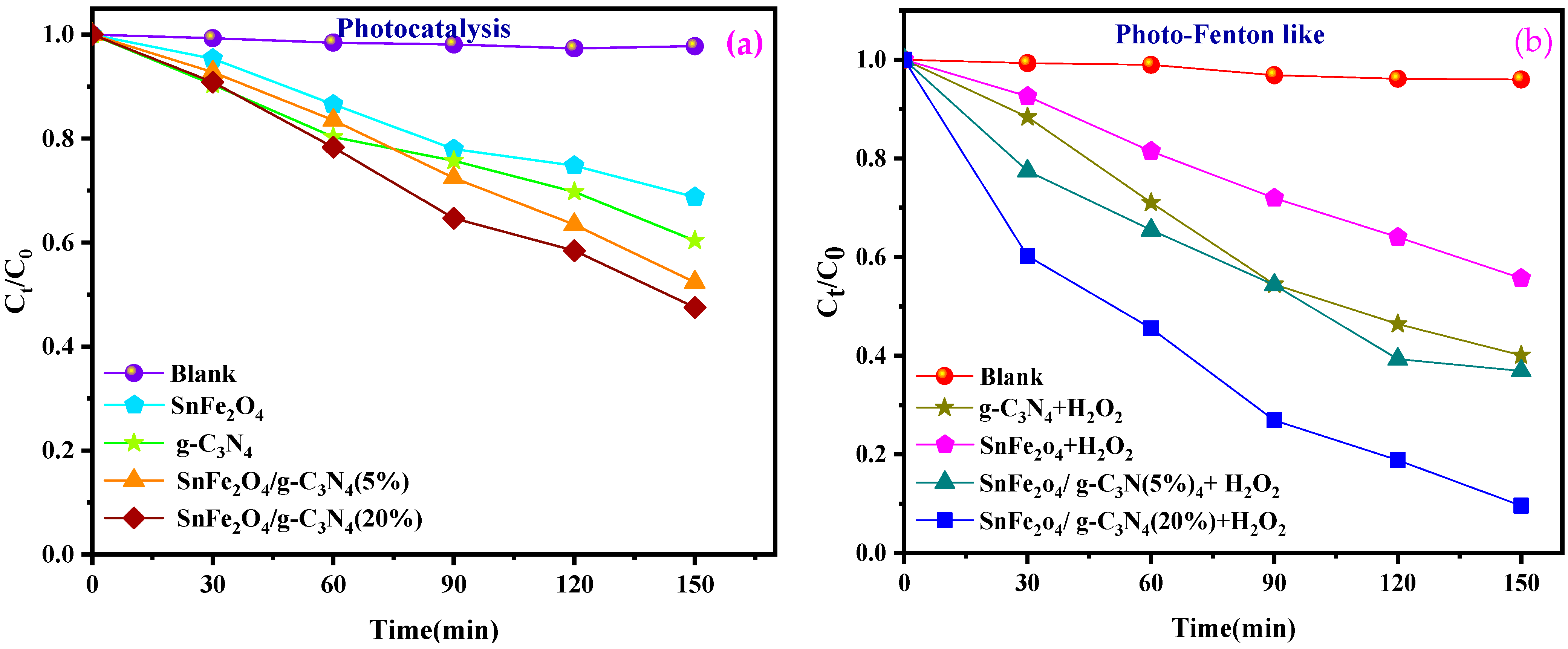
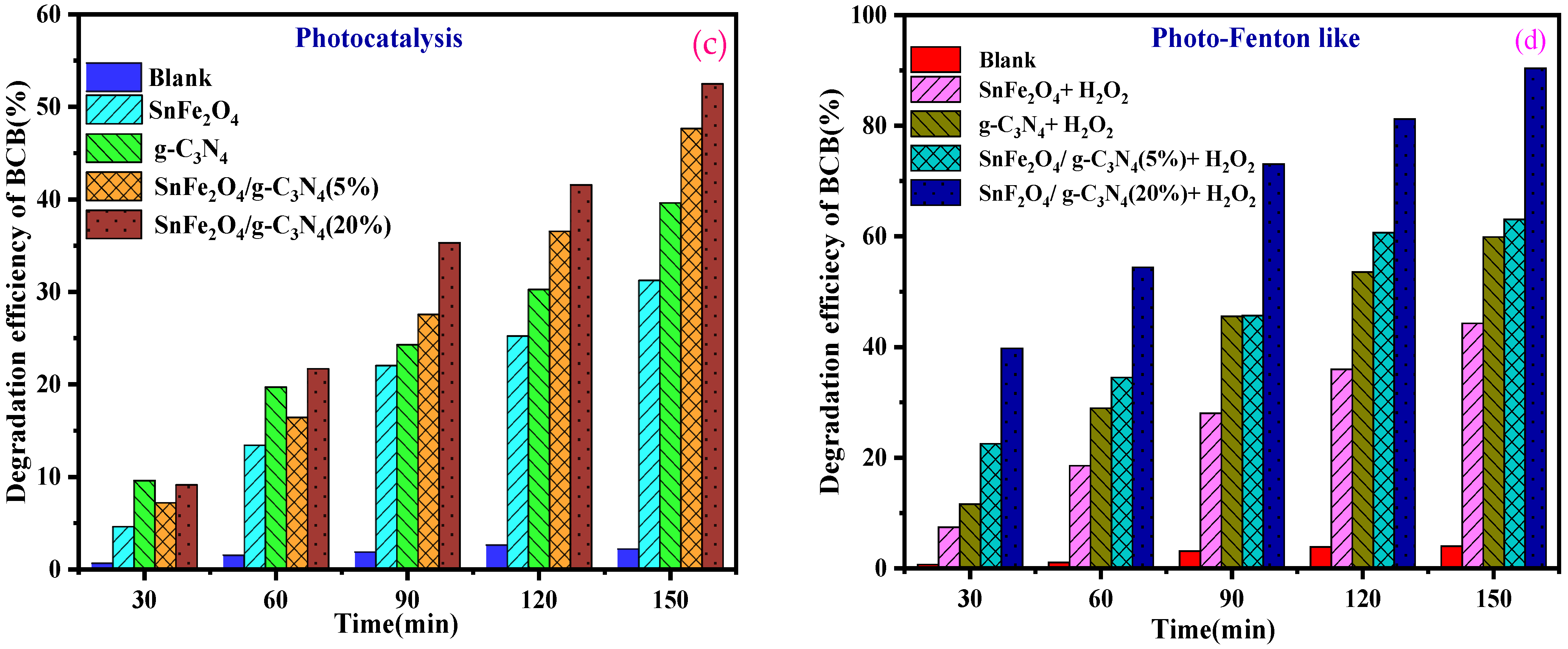

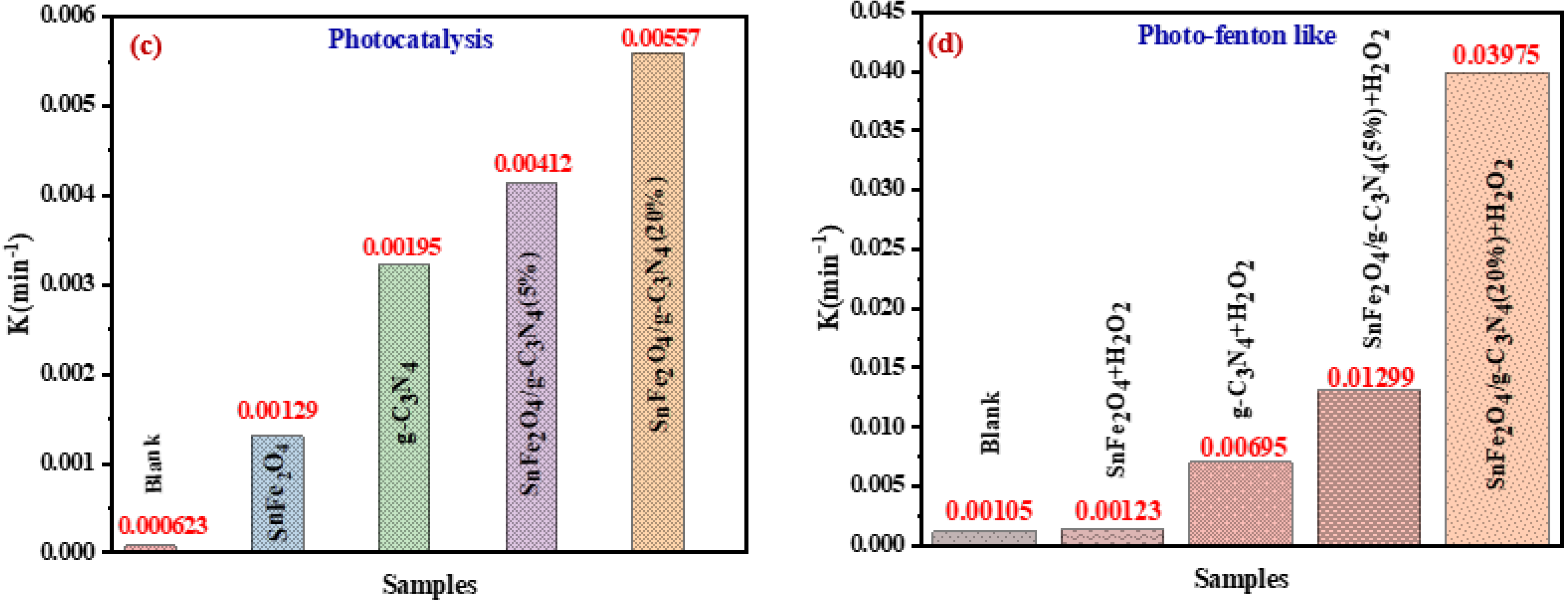
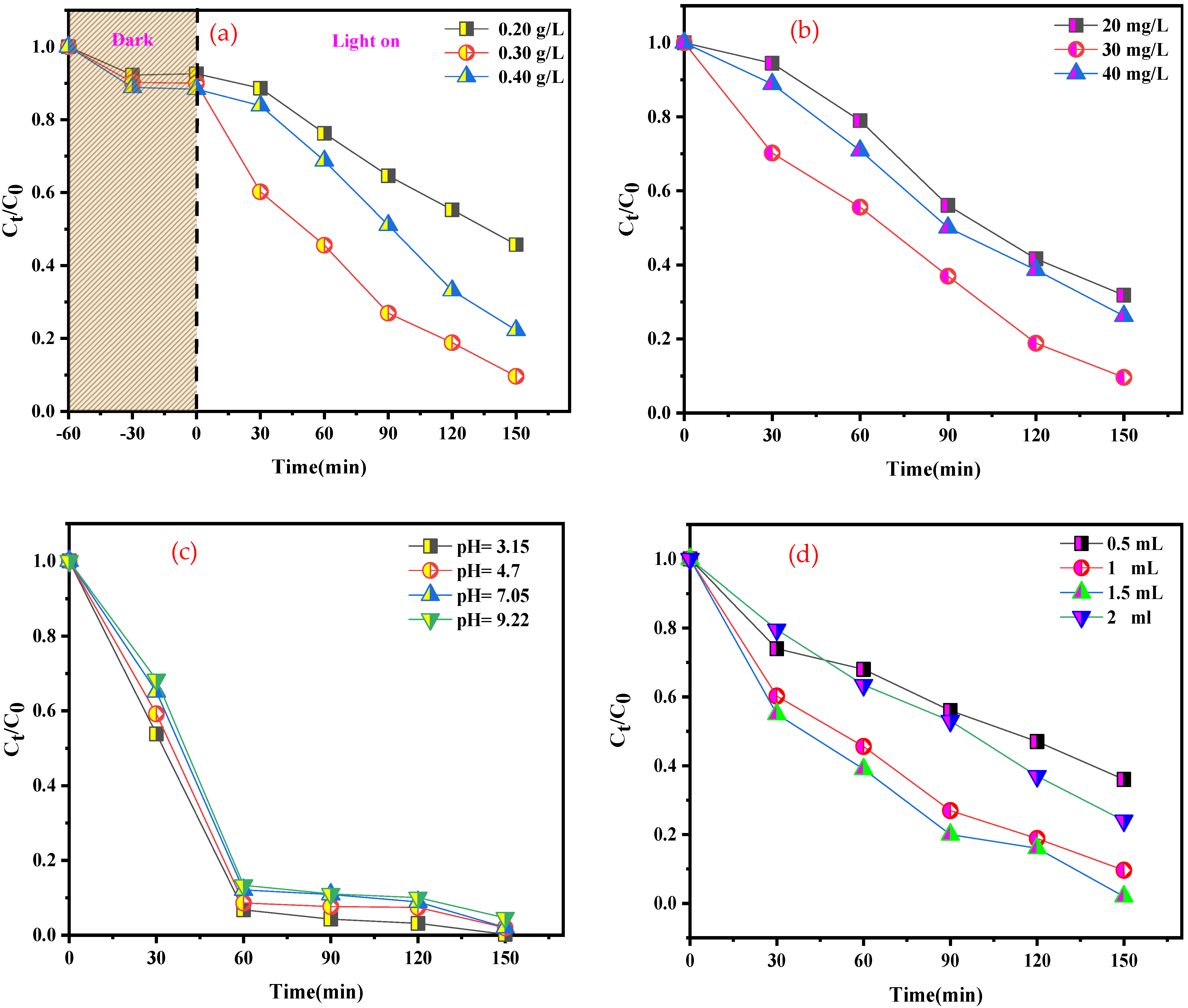



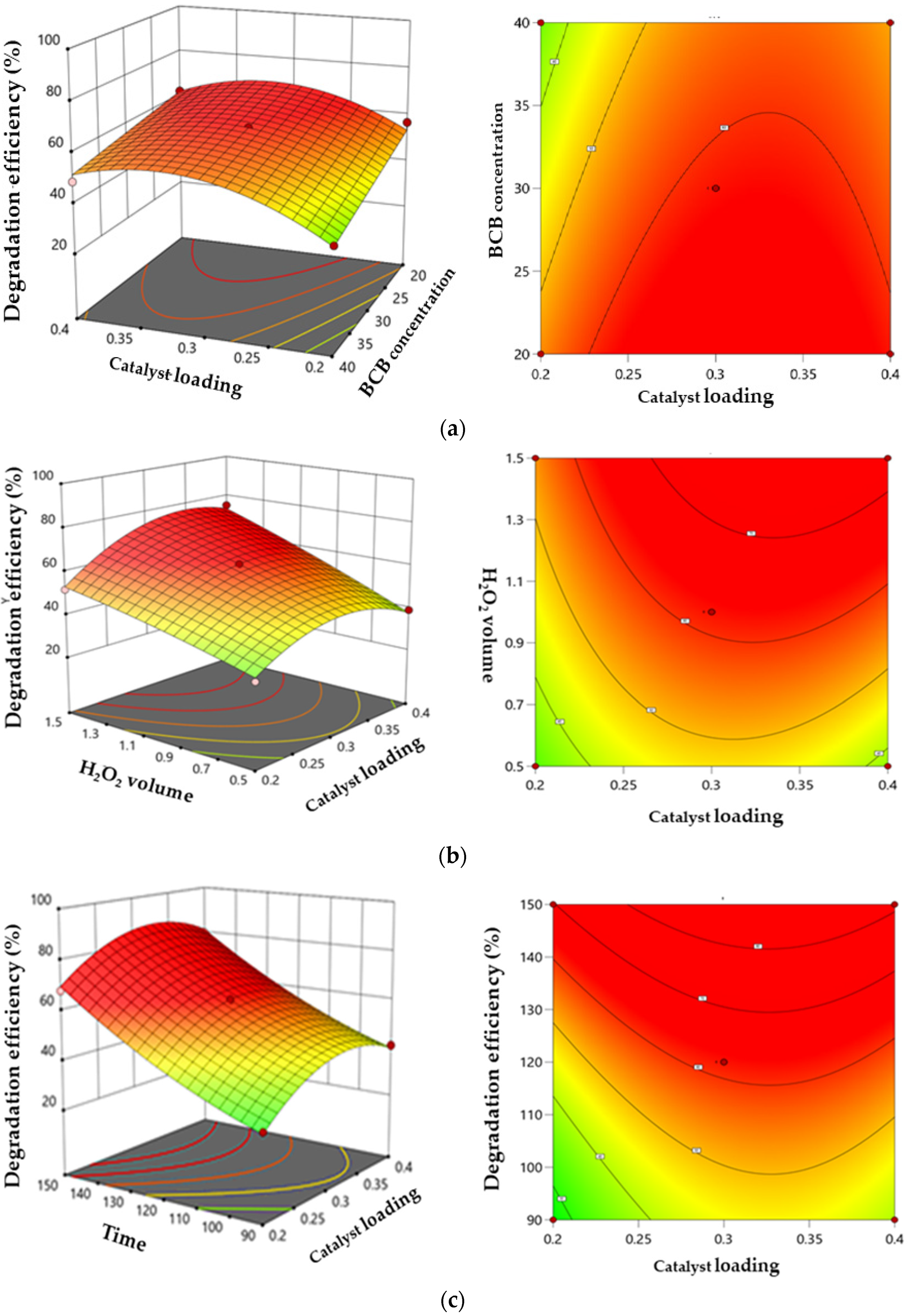
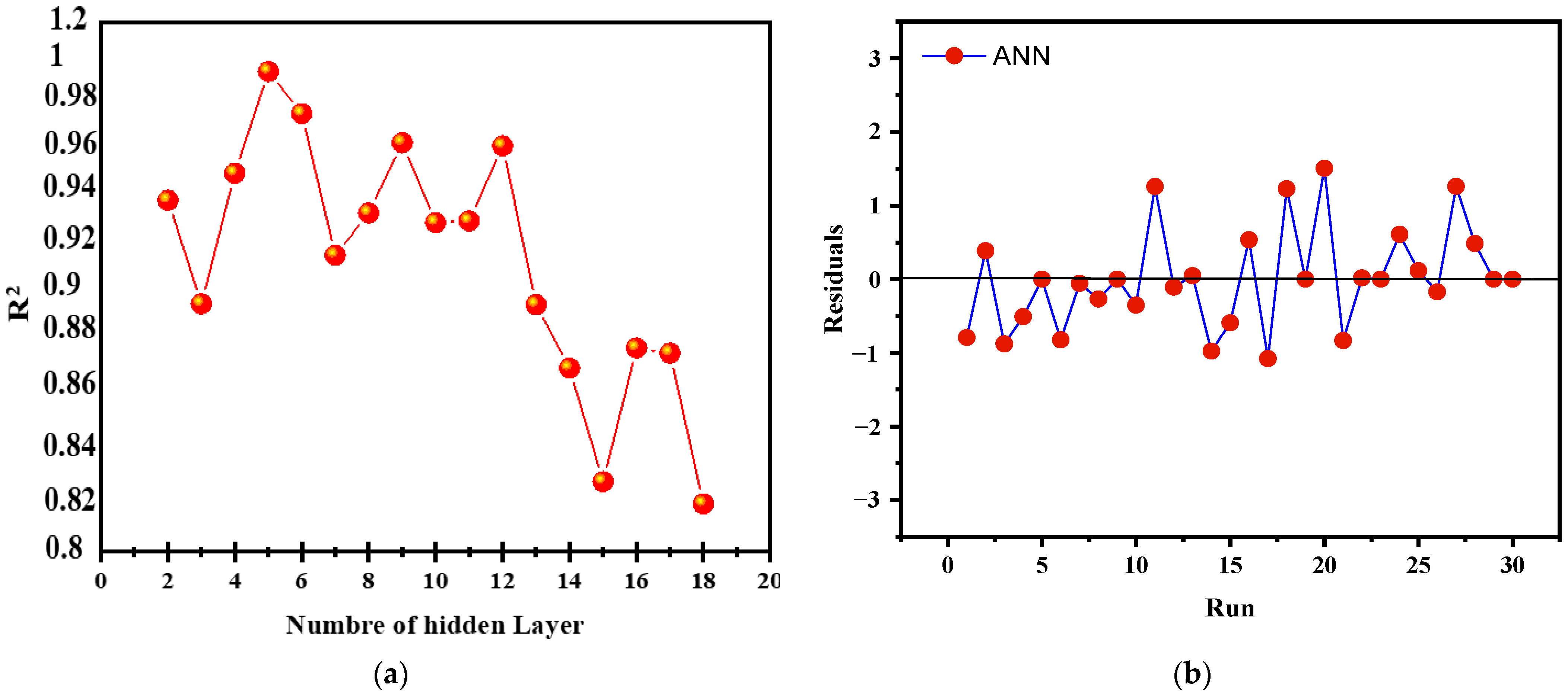

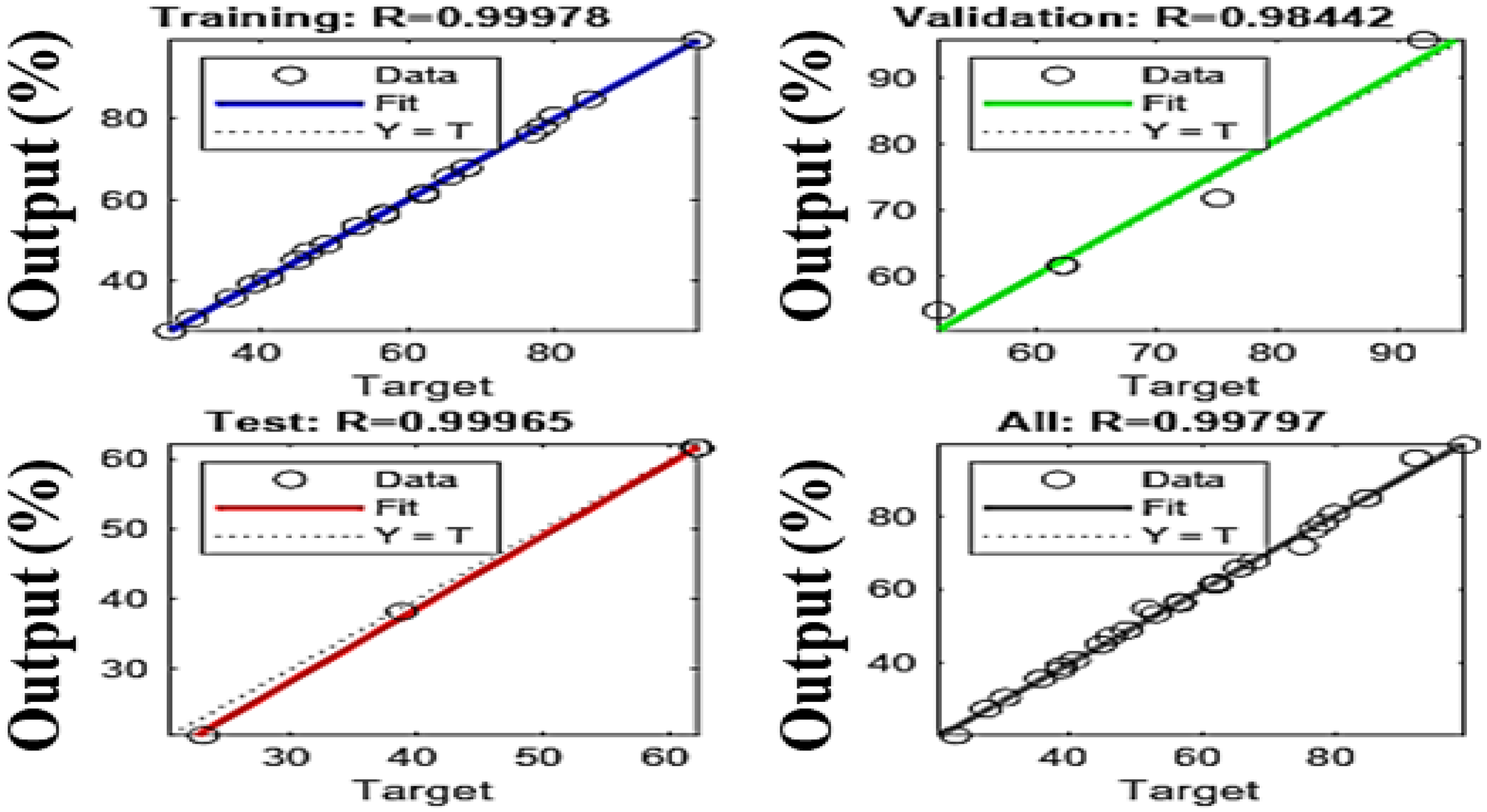

| Coded Factors | Actual Factors | Unit | Low (−1) | Center (0) | High (+1) |
|---|---|---|---|---|---|
| X1 | Catalyst loading | g L−1 | 0.2 | 0.3 | 0.4 |
| X2 | BCB concentration | mg L−1 | 20 | 30 | 40 |
| X3 | Volume of H2O2 | mL | 0.5 | 1 | 1.5 |
| X4 | Contact time | min | 90 | 120 | 150 |
| Catalysts | Pollutant | Initial Conc. | H2O2 Dosage | Catalysts Loading | Light Source | % Removal | References |
|---|---|---|---|---|---|---|---|
| SnFe2O4/g-C3N4 | BCB | 20 mg L−1 | (1 mL in 100 mL) | 0.3 g L−1 | LED | 94% within 150 min | This study |
| ZnFe2O4/g-C3N4 | MB | 20 mg L−1 | (1 mL in 50 mL) | 0.5 g L−1 | Natural sunlight | 99.5% within 60 min | [50] |
| NiFe2O4/gC3N4 | RhB | 20 mg L−1 | ~0.2 M | 1 g L−1 | LED | 98% within 90 min | [51] |
| p-CuFe2O4/n-g-C3N4 | MO | 20 mg L−1 | (0.5 mL in 100 mL) | 0.1 g L−1 | 300 W Xenon lamp | 98% within 300 min | [52] |
| NiFe2O4/g-C3N4 | MB | 10 mg L−1 | (1 mL in 50 mL) | 0.5 mg L−1 | 300 W Xenon lamp | 87% within 240 min | [53] |
| Source | Sum of Squares | df | Mean Square | F-Value | p-Value | |
|---|---|---|---|---|---|---|
| Model | 10,130.59 | 14 | 723.61 | 84.55 | <0.0001 | significant |
| X1 | 469.48 | 1 | 469.48 | 54.86 | <0.0001 | |
| X2 | 570.63 | 1 | 570.63 | 66.68 | <0.0001 | |
| X3 | 2465.48 | 1 | 2465.48 | 288.09 | <0.0001 | |
| X4 | 5404.27 | 1 | 5404.27 | 631.49 | <0.0001 | |
| X1X2 | 14.55 | 1 | 14.55 | 1.70 | 0.2119 | |
| X1X3 | 55.90 | 1 | 55.90 | 6.53 | 0.0219 | |
| X1X4 | 0.3721 | 1 | 0.3721 | 0.0435 | 0.8376 | |
| X2X3 | 5.56 | 1 | 5.56 | 0.6500 | 0.4327 | |
| X2X4 | 39.08 | 1 | 39.08 | 4.57 | 0.0495 | |
| X2X4 | 30.16 | 1 | 30.16 | 3.52 | 0.0801 | |
| X12 | 891.82 | 1 | 891.82 | 104.21 | <0.0001 | |
| X22 | 3.943 × 10−6 | 1 | 3.943 × 10−6 | 4.608 × 10−7 | 0.9995 | |
| X32 | 17.66 | 1 | 17.66 | 2.06 | 0.1714 | |
| X42 | 76.25 | 1 | 76.25 | 8.91 | 0.0093 | |
| Residual | 128.37 | 15 | 8.56 | |||
| Lack of Fit | 128.37 | 10 | 12.84 | 2.271 × 105 | <0.0001 | significant |
| Pure Error | 0.0003 | 5 | 0.0001 | |||
| Cor Total | 10,258.96 | 29 |
| Empty Cell | Statistical Parameters | ||
|---|---|---|---|
| RMSE | MAE | R2 | |
| RSM | 1.672 | 1.013 | 0.97 |
| ANN | 1.22 | 0.99 | 0.9996 |
Disclaimer/Publisher’s Note: The statements, opinions and data contained in all publications are solely those of the individual author(s) and contributor(s) and not of MDPI and/or the editor(s). MDPI and/or the editor(s) disclaim responsibility for any injury to people or property resulting from any ideas, methods, instructions or products referred to in the content. |
© 2025 by the authors. Licensee MDPI, Basel, Switzerland. This article is an open access article distributed under the terms and conditions of the Creative Commons Attribution (CC BY) license (https://creativecommons.org/licenses/by/4.0/).
Share and Cite
Elkahoui, Y.; Abahdou, F.-Z.; Ben Ali, M.; Alahiane, S.; Elhabacha, M.; Boutarba, Y.; El Hajjaji, S. Photocatalytic and Photo-Fenton-like Degradation of Cationic Dyes Using SnFe2O4/g-C3N4 Under LED Irradiation: Optimization by RSM-BBD and Artificial Neural Networks (ANNs). Reactions 2025, 6, 23. https://doi.org/10.3390/reactions6020023
Elkahoui Y, Abahdou F-Z, Ben Ali M, Alahiane S, Elhabacha M, Boutarba Y, El Hajjaji S. Photocatalytic and Photo-Fenton-like Degradation of Cationic Dyes Using SnFe2O4/g-C3N4 Under LED Irradiation: Optimization by RSM-BBD and Artificial Neural Networks (ANNs). Reactions. 2025; 6(2):23. https://doi.org/10.3390/reactions6020023
Chicago/Turabian StyleElkahoui, Yassine, Fatima-Zahra Abahdou, Majda Ben Ali, Said Alahiane, Mohamed Elhabacha, Youssef Boutarba, and Souad El Hajjaji. 2025. "Photocatalytic and Photo-Fenton-like Degradation of Cationic Dyes Using SnFe2O4/g-C3N4 Under LED Irradiation: Optimization by RSM-BBD and Artificial Neural Networks (ANNs)" Reactions 6, no. 2: 23. https://doi.org/10.3390/reactions6020023
APA StyleElkahoui, Y., Abahdou, F.-Z., Ben Ali, M., Alahiane, S., Elhabacha, M., Boutarba, Y., & El Hajjaji, S. (2025). Photocatalytic and Photo-Fenton-like Degradation of Cationic Dyes Using SnFe2O4/g-C3N4 Under LED Irradiation: Optimization by RSM-BBD and Artificial Neural Networks (ANNs). Reactions, 6(2), 23. https://doi.org/10.3390/reactions6020023






